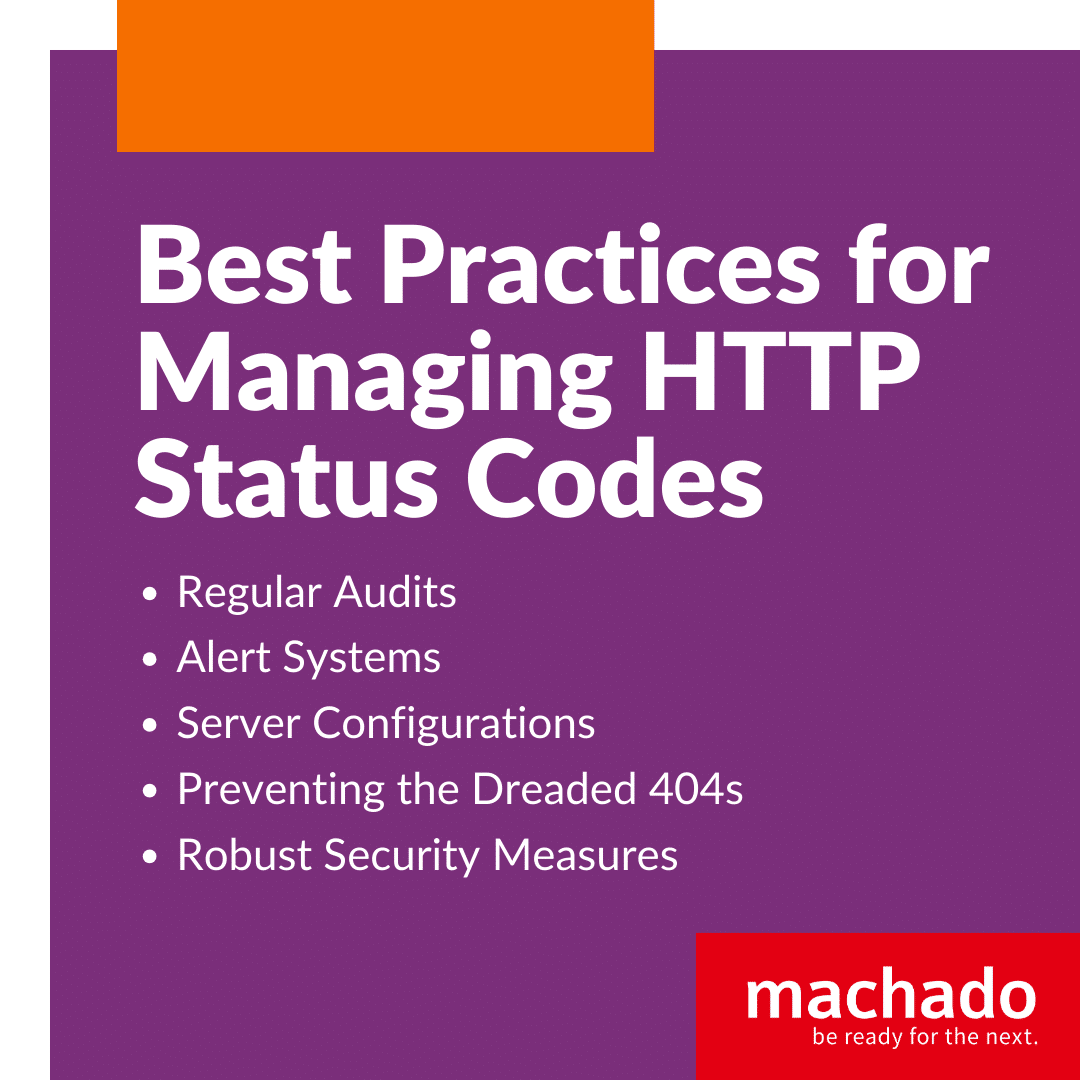TL;DR: In this indepth article, discover how HTTP Errors can significantly impact user experience, SEO rankings, and overall business operations. Understanding and proactively managing these errors is essential for your digital success.
Decode Errors, Boost Performance, and Get Proactive
Ever landed on a webpage and been greeted with a mysterious “404 Not Found” message?
Or perhaps, you’ve been redirected a couple of times before reaching your intended page?
These little interruptions, known as HTTP status codes, can spell the difference between a satisfied customer and a missed opportunity.
But here’s the thing: these aren’t just random numbers or trivial glitches.
These codes are like the pulse of your website, giving you vital insights into its health.
You might be wondering, “Why should I, as a business owner, care about some technical jargon?”
Well, stick with me, and I’ll show you how understanding these codes can skyrocket your user experience, boost your SEO, and smoothen out those pesky operational hitches.
And for the IT managers reading this, especially if you’re just stepping into the role, trust me, this knowledge is pure gold.
By the end, I’ll also introduce you to a secret weapon – our proactive approach.
It’s like having a guardian angel over your shoulder, always on the lookout, ensuring everything’s running smoothly.
But more on that later…
Decoding HTTP Status Codes: A Primer
Picture this: You walk into a store, and instead of a warm greeting, you get a code – “Aisle 404: Product Not Found.”
Confusing, right? That’s how your users feel when they encounter these HTTP status codes on your website.
So, What Exactly Are HTTP Status Codes?
In the simplest terms, HTTP status codes are the web’s way of telling you how things went when your browser (or any client) requested a particular page or resource.
Think of them as feedback or short messages from the website’s server.
Breaking Down the Error Code Categories
To make things easy (because who likes complicated stuff?), these status codes are grouped into categories, each starting with a specific digit:
1xx (Informational): Just like it sounds, these codes give you a heads-up about what the server is doing. It’s still processing your request, so hang tight!
2xx (Successful): High-fives all around! 🙌 This means your request was successful. The one you’ll see most often? 200 – OK, which is the digital equivalent of a thumbs-up.
3xx (Redirection): These codes tell you the page isn’t here but has moved somewhere else. It’s like being redirected to another aisle in our store analogy.
4xx (Client Errors): Oops! These indicate that the mistake is on your end. Maybe you typed the URL wrong, or perhaps you’re trying to access something off-limits.
5xx (Server Errors): Yikes. These codes mean the server itself is having issues. It’s like the store’s internal system crashing. These are particularly important for businesses to monitor and address quickly.
Why do these codes matter, you ask? Because every time a user stumbles upon a “Product Not Found” scenario (aka a 404 error), it’s a potential lost sale, a frustrated customer, and a ding to your SEO rankings.
But here’s the silver lining: with the right knowledge and a proactive approach, like the one an MSP brings to the table, you can turn these codes from hurdles into opportunities.
Stay with me as we dive deeper into these categories in the coming sections. And trust me, by the end of this series, these numbers won’t feel like alien language but invaluable insights for your digital empire.
Focusing on Redirection: The Magic of 3xx Codes
Imagine you’re headed to your favorite café, only to find a sign on the door that says they’ve moved across the street.
It’s a bit of a detour, but you find your way there because of that sign.
In the digital realm, 3xx codes are that sign, guiding your users to where they need to be.
Understanding the 3xx Redirection Codes
Let’s break down some of the most common 3xx redirection codes and what they tell us:
301 Moved Permanently: Picture this as the café deciding to permanently set up shop across the street. They’re never going back. This tells search engines and visitors that a page or resource has moved for good. For business owners, this is crucial when reorganizing or renaming web pages, ensuring that the SEO juice from the old page isn’t lost.
302 Found/Temporary Redirect: Now, imagine the café temporarily relocating because they’re renovating. They’ll be back in their original spot soon. Similarly, a 302 status code means the move is temporary. But, a word of caution here: use this carefully. If misused, it can confuse search engines and affect your SEO.
303 See Other: This one’s a bit techy, but stick with me. Imagine you make an order at a new café, and instead of serving you right there, they guide you to their partner café next door for your order. The 303 status is similar: it essentially tells the browser that it can find the response to its request elsewhere.
304 Not Modified: Ever walked into the café and realized their menu hasn’t changed since your last visit? This code tells the browser that the web page hasn’t changed since it last checked. So, instead of downloading it all over again, the browser can use the version it already has saved, making things a tad faster.
307 Temporary Redirect & 308 Permanent Redirect: Think of these as more specific versions of the 301 and 302 redirects. While they serve a similar purpose, they ensure the method of the request (like GET or POST) remains unchanged. A bit like insisting you want your coffee served exactly the same way even if you’re directed to a different counter.
Wrapping up the 3xx section, redirection might seem like a mere detour, but here’s the golden nugget: How smoothly you handle these detours can make or break your user experience. And remember, a happy user often leads to a loyal customer.
Client Errors: Navigating the Tricky Terrain of 4xx Codes
Okay, let’s take another trip to our café – but this time, things aren’t as smooth.
You try to order an exotic coffee blend, but they can’t understand your request.
Or perhaps you’re trying to access the staff-only section of the café.
These snags?
That’s the world of 4xx codes for you.
Deciphering the 4xx Client Error Codes
Just as in our café, understanding these errors can make the difference between a smooth digital journey and a potential business hiccup.
Let’s take a closer look:
400 Bad Request: Picture trying to order a coffee in a completely made-up language. The barista is confused, right? This is the digital version of that. The request your browser made was somehow incorrect or corrupted. Solving it usually means checking the URL or data sent in the request.
401 Unauthorized & 403 Forbidden: These two are like trying to sneak into the café’s kitchen. The 401 means you haven’t shown your ‘badge’ (or login credentials) to access a restricted area, while 403 is the café telling you that even with a badge, you’re not allowed in there. Essentially, it’s about understanding the difference between authentication (proving who you are) and authorization (permissions for what you can do).
404 Not Found: Ah, the infamous 404. It’s like walking into the café and realizing they don’t serve your favorite pastry anymore. It’s gone. For websites, this means a page doesn’t exist, and it’s a major UX and SEO hiccup. Every 404 can potentially derail a visitor’s journey, and search engines don’t look kindly on too many of these either.
429 Too Many Requests: Picture a scenario where you keep asking the barista for more and more refills in rapid succession. They’ll eventually tell you to slow down, right? This code is the server’s way of saying the same thing. It often arises from rate limiting, ensuring that users or bots don’t overwhelm a website. If not handled, it could be an indicator of potential security threats or DDoS attacks.
Now, the 4xx codes might seem daunting, but here’s the deal: Awareness is half the battle won. Recognizing these errors and their implications allows businesses to take swift corrective measures.
Remember our proactive secret weapon?
Yep, a Proactive Managed Service Provider (MSP).
With an MSP in your corner, many of these potential pitfalls can be identified and addressed before they even affect your end-users.
That means fewer frustrated visitors and more seamless interactions.
Protective Server Monitoring: Your Digital Guardian Angel
Remember that security guard at the entrance of some fancy clubs or buildings?
The one who keenly observes everything, ensuring no troublemakers enter? Protective server monitoring plays that guardian role, keeping an eagle eye on everything that’s happening.
What Exactly Is Protective Server Monitoring?
At its core, protective server monitoring is like the café’s security system, constantly scanning for anything out of the ordinary. It observes server health, traffic patterns, and any potential errors, ensuring everything runs like a well-oiled machine.
Detect, Diagnose, Alert
When it comes to 3xx and 4xx codes, the value of this kind of monitoring is immeasurable. Let’s say there’s a sudden surge in 404 errors after a website update. A good monitoring system can detect this spike, diagnose the root cause (perhaps some pages got accidentally removed), and instantly alert the relevant team.
No more waiting for customer complaints or negative reviews!
The Proactive Shift
Here’s where things get really exciting. Traditionally, monitoring was passive — it just observed and reported. But with advanced tools and MSP support, businesses can move to active response.
This means not just spotting potential issues but automatically initiating steps to resolve them. Imagine if our café not only spotted a spill but had a robot instantly cleaning it up!
The Very Real Implications of Overlooking HTTP Status Codes
You might wonder, “Are these HTTP codes truly that important?” Oh, absolutely. The digital realm’s subtleties can have tangible effects in the real world. Let’s explore.
User Trust and Experience
Consider our café again. Consistent bad experiences, like being denied your order or not finding what you want, can deter you from coming back, right? Similarly, recurring HTTP errors damage user trust and sour their experience. Each error can be a lost sale, a missed opportunity, or a negative review waiting to happen.
SEO Implications
Search engines, like Google, are like the café critics. They notice everything, and trust me, they care deeply about user experience. Too many 404s? Slow redirects? These can all pull your website down in rankings, making you lose out on organic traffic and potential business.
Real-World Ripples:
Let’s get down to brass tacks with some real-life examples. Major online retailers have lost millions due to simple glitches during sale events. Prominent news websites have seen sharp dips in traffic due to mismanaged redirects. Each of these tales underscores the importance of managing and monitoring HTTP codes effectively.
To tie things up neatly: In the bustling café of the digital landscape, HTTP status codes are your cues, signs, and signals. They tell a story. And with a proactive approach, supported by the vigilant eyes of an MSP, you can ensure this story is always one of success, growth, and positive user experiences.
Best Practices for Managing HTTP Status Codes
We’ve traversed through the nuanced alleys of HTTP status codes, much like exploring a city’s vibrant streets. Now, as any seasoned traveler will tell you, there are always some tried and tested hacks to make the journey smoother. Let’s delve into the best practices, your essential toolkit for navigating the city of HTTP codes:
Regular Audits: Just as you’d frequently check your café’s inventory, conduct regular health checks of your website. This proactive approach can help nip potential issues in the bud.
Alert Systems: Set up mechanisms that notify you about unusual spikes in specific codes. It’s akin to an alarm system at our café, immediately alerting you if something’s amiss.
Server Configurations: Ensure your servers are properly set up. Think of it as the café’s foundation; a well-laid foundation promises a stable structure.
Preventing the Dreaded 404s: Continually review your website content. It’s like making sure every item on the café menu is available. No customer should ask for something and hear, “Sorry, we don’t have that.”
Robust Security Measures: A strong security system isn’t just about protecting assets but also ensuring patrons feel safe. Safeguard your online presence against unauthorized access and potential threats.
Tools & Resources: The IT Manager’s Digital Arsenal
While our café analogies give a vivid picture, the digital world boasts tools and resources to simplify our tasks. Let’s look at the must-haves for every modern IT manager:
Server Monitoring Tools: There are popular platforms that act as your digital watchdogs, always alert and always vigilant. Tools like Nagios, SolarWinds, and PRTG Network Monitor come to mind.
HTTP Diagnostic Platforms: Tools such as Google’s URL Inspection Tool or Redirect Path can help you identify and analyze HTTP status code issues, ensuring your website’s health is always at its prime.
Learning and Updates: In the ever-evolving world of tech, staying updated is vital. Consider subscribing to authoritative blogs, forums, and attending webinars. Websites like MDN Web Docs or Stack Overflow can be valuable allies in your digital journey.
Conclusion: HTTP Codes
As we wind down our journey through this bustling digital café, let’s remember: every beep, alert, and code is a note in the grand symphony of the online realm. When managed well, these codes come together in harmony, resulting in a delightful user experience, a search engine’s nod of approval, and smooth business operations.
But it’s not just about managing these notes; it’s about mastering them. By being proactive, by arming yourself with knowledge and the right tools, and with the vigilant support of an MSP, you’re not just responding to the digital world but orchestrating it.
So, the next time you encounter an HTTP status code, remember it’s more than just a number. It’s a call to action, an opportunity to excel. Here’s to your continuous digital crescendo!
Don’t Leave Performance to Chance!
Unlock the full potential of your server with our FREE health assessment.
Dive deep, spot inefficiencies, and supercharge your operations. Your server’s peak performance is just a click away.
Contact us today to Claim Your Free Assessment!
Download our guide to learn how you can get more done with your current IT staff.Be Ready for the Next IT Opportunity






